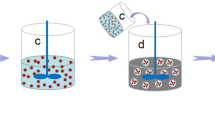Abstract
Microcapsules containing self-healing agents have been introduced into polymer to self-heal the microcracks and toughen the brittle matrix. Poly(urea–formaldehyde) (PUF) microcapsules containing epoxy resins are potential for the self-healing and toughening polymer. The resistance to medium surroundings of microcapsules is required. In the present study, PUF microcapsules containing epoxy resins were prepared by in situ polymerization. The effects of diameter, surface morphology and wall thickness on the permeability and stability of microcapsules in thermal and solvent surroundings were investigated. The morphology of microcapsule was investigated using optical microscope (OM), metalloscope (MS) and scanning electron microscope (SEM), respectively. The composition on the surface of microcapsule was analyzed by using energy dispersive analysis of X-ray (EDAX). The thermal properties of microcapsules were investigated using differential scanning calorimetry (DSC) and thermogravimetry analysis (TGA). The thermal permeability of core increases and the stability of microcapsule decreases with the enhancement of heating temperature mainly due to the expansion of epoxy resins below 251 °C and the decomposition of PUF above 251 °C. At room temperature, the permeability constants of core materials of microcapsules in acetone solvent are small and they are 1.20 × 10−3 m s−1, 1.39 × 10−3 m s−1 and 1.60 × 10−3 m s−1 corresponding to the microcapsules with diameters of 400 ± 50 μm, 230 ± 40 μm and 120 ± 30 μm. Increasing the surface smoothness, diameter and wall thickness can decrease the permeability and improve the stability of microcapsules in thermal and solvent surroundings.







Similar content being viewed by others
References
Devy J, Balasse E, Kaplan H, Madoulet C, Andry MC (2006) Int J Pharm 307:194
Povey AC, Bartsh H, O’Neill IK (1987) Cancer Lett 36:45
Alabi AO, Che Cob Z, Jones DA, Latchford JW (1999) Aquac Int 7:137
Yúfera M, Pascual E, Fernández-Díaz C (1999) Aquaculture 177:249
McMaster LD, Kokott SA, Slatter P (2005) World J Microbiol Biotechnol 21:723
Kumar A, Stephenson LD, Murray JN (2006) Prog Org Coat 55:244
Choi HJ, Lee YH, Kim CA, Jhon MS (2000) J Mater Sci Lett 19:533
Park SY, Cho MS, Kim CA, Choi HJ, Jhon MS (2003) Colloid Polym Sci 282:198
Kim KS, Lee JY, Park BJ, Sung JH, Chin I, Choi HJ, Lee JH (2006) Colloid Polym Sci 284:813
Jang IB, Sung JH, Choi HJ (2005) J Mater Sci 40:1031
White SR, Sottos NR, Geubelle PH, Moore JS, Kessler MR, Sriram SR, Brown EN, Viswanathan S (2001) Nature 409:794
Jung D, Hegeman A, Scottos NR, Geubelle PH, White SR (1997) ASME MD-80:265
Kessler MR, Sottos NR, White SR (2003) Composites: Part A 34:743
Brown EN, White SR, Sottos NR (2002) J Microencapsul 2:139
Kessler MR, White SR (2001) Composites: Part A 32:683
Brown EN, White SR, Sottos NR (2005) Compos Sci Technol 65:2474
Park SJ, Shin YS, Lee JR (2001) J Colloid Interface Sci 241:502
Guo HL, Zhao XP (2004) Opt Mater 26:297
Lee YH, Kim CA, Jang WH, Choi HJ, Jhon MS (2001) Polymer 42:8277
Lee SJ, Rosenberg M (1999) J Controll Release 61:123
Makino K, Mack EJ, Okano T, Kim SW (1990) J Controll Release 12:235
Takao M, Tetsuya T, Ichiro C (1973) BBA – Enzymology 321:653
Bryant YG (1999) ASM BED 44:225
Camino G, Operti L, Trossarelli L (1983) Polym Degrad Stab 3:161
Takamura K, Koishi M, Kondo T (1971) Polymere 248:929
Acknowledgements
The work was supported by the special research foundation of doctoral subject from the education department of high school (20050699034) and the graduate staring seed fund of Northwestern Polytechnical University (Z200584).
Author information
Authors and Affiliations
Corresponding author
Rights and permissions
About this article
Cite this article
Yuan, L., Liang, GZ., Xie, JQ. et al. The permeability and stability of microencapsulated epoxy resins. J Mater Sci 42, 4390–4397 (2007). https://doi.org/10.1007/s10853-006-0606-6
Received:
Accepted:
Published:
Issue Date:
DOI: https://doi.org/10.1007/s10853-006-0606-6



